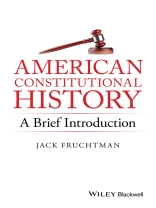American Constitutional History presents a concise introduction to the constitutional developments that have taken place over the past 225 years, treating trends from history, law, and political science.
- Presents readers with a brief and accessible introduction to more than two centuries of U.S. constitutional history
- Explores constitutional history chronologically, breaking U.S. history into five distinct periods
- Reveals the full sweep of constitutional changes through a focus on issues relating to economic developments, civil rights and civil liberties, and executive power
- Reflects the evolution of constitutional changes all the way up to the conclusion of the June 2015 Supreme Court term
Spis treści
Acknowledgments xi
Prologue xiii
Structure of the Book xvii
Part 1 The New Republic, 1781–1828 1
John Locke, Deism, and Religious Liberty 5
1 Ideological Origins of the New Republic 9
The Articles of Confederation and the Constitutional Convention 10
Ratification and the Bill of Rights 21
2 Representative and Constitutional Democracy 28
Judicial Review, Judicial Duty 31
Economic Policy in the New Republic 35
3 Nationalization of the Constitution and Executive Power 45
Part 2 The Slave Republic, 1789–1877 53
Constitutional Amendments 56
4 Commerce, Nullification, and Slavery 59
Other Economic Rulings 60
The Nullification Controversy 62
Dred Scott 65
5 Civil War and Reconstruction 70
Lincoln and War 71
Reconstruction 78
6 Rights and Privileges 84
Privileges and Immunities 86
Women’s Rights 89
Persecution of Newly Freed Slaves 91
Part 3 The Free Market Republic, 1877–1937 95
Constitutional Amendments 96
7 The Development of Substantive Due Process 99
Procedural Due Process 100
Substantive Due Process 101
Restraint of Trade in the Free Market Era 105
Liberty of Contract 107
Regulating Industry 111
The Great Depression 113
8 Civil Rights After Reconstruction 115
Equality and African‐Americans 115
Parents and Educational Rights 123
The Right to be Let Alone 125
9 The Re‐emergence of Executive Power 126
Leadership and the Presidency 126
America and World War I 128
Criminal Anarchy and Criminal Syndicalism in the 1920s 137
Part 4 The Welfare State Republic, 1937–1995 143
Constitutional Amendments 144
10 Advocates and Enemies of Social Welfare 147
The Court Changes 149
New Social Welfare Programs 153
11 The Growth of Civil Liberties 154
Free Expression 154
Free Press 158
Religious Establishments 160
Criminal Suspects and Capital Punishment 164
Privacy 167
12 The Civil Rights Movement 172
School Desegregation 172
Civil and Voting Rights 175
Strict Scrutiny and Affirmative Action in Higher Education 177
Affirmative Action in Government Contracts 181
Women’s Rights and Affirmative Action 182
13 Expanding Presidential Power 186
Presidential Power and Japanese Internments 187
Military Tribunals 191
Vietnam and its Aftermath 192
Re‐emergence of a Powerful Executive 195
Part 5 The Contemporary Republic, 1995–2013 199
14 Federal Commerce Power and Economic Regulation 201
Narrowing Federal Commerce Power 202
Health‐care Reform 205
15 Rights, Liberties, and Judicial Doctrines 209
Affirmative Action and Education 209
Campaign Finance 212
The Right to Bear Arms 213
Capital Punishment 216
The Right to Privacy 218
Religious Establishments 220
16 Executive Authority and Terrorism 224
Protecting America in an Era of Terrorism 224
Wars in Afghanistan and Iraq 229
Executive Power Under Barack Obama 233
Epilogue 239
Government and the Economy 241
Government and Individual and Civil Rights 243
Executive Power 254
A Republic if you can Keep it 257
Bibliography 260
Prologue 261
Part 1: The New Republic, 1781–1828 262
Part 2: The Slave Republic, 1789–1877 263
Part 3: The Free Market Republic, 1877–1937 263
Part 4: The Welfare State Republic, 1937–1995 264
Part 5: The Contemporary Republic, 1995–2013 265
Epilogue 267
Index 268
O autorze
Jack Fruchtman is Professor of Political Science and Director of the Program in Law and American Civilization at Towson University, Maryland. His most recent books include
The Political Philosophy of Thomas Paine (2009) and
The Supreme Court: Rulings on American Government and Society (2nd Edition, 2014).












